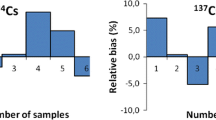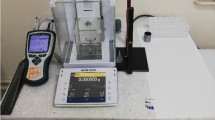Abstract
Results from proficiency tests gathered over the past two decades by the laboratory for low level radioactivity measurements for liquid scintillation counting of 3H (184 results) and 14C (74 results) are used to verify the validated measurement methods used by the laboratory, in particular the estimated uncertainty budget of the method and its reproducibility and stability. A linear regression approach is used for the analysis of the results, described in the literature as the long term uncertainty in measurement method. The present study clearly indicates the advantages of using proficiency test results in identifying possible constant or proportional bias effects as well as the possibility to compare the laboratory performance with the performance of peer laboratories.




Similar content being viewed by others
References
ISO 9001 (2015) Quality management systems—requirements
ISO-17025 (2005) General requirements for the competence of testing and calibration laboratories
ISO-15189 (2012) Medical laboratories—requirements for quality and competence
Magnusson G, Örnemark U (eds) (2nd ed) (2014) Eurachem guide: the fitness for purpose of analytical methods—a laboratory guide to method validation and related topics. ISBN 978-91-87461-59-0. www.eurachem.org. Accessed 28 May 2017
Weitzel JML, Lee SM, Smoot M, Viafara N and Brodsky M (2007) How to meet ISO-17025 requirements for method verification. AOAC International. www.aoac.org. Accessed 28 May 2017
ISO-11929 (2010) Determination of the characteristic limits (decision threshold, detection limit and limits of the confidence interval) for measurements of ionizing radiation—Fundamentals and application
GUM (2008) Evaluation of measurement data—guide to the expression of uncertainty in measurement. www.bipm.org. Accessed 28 May 2017
Ellison SLR, Williams A (eds) (3th ed) (2012) Eurachem/CITAC Guide CG 4; Quantifying uncertainty in analytical measurement. ISBN 978-0-948926-30-3. www.eurachem.org. Accessed 28 May 2017
Meijer P, de Maat MP, Kluft C, Haverkate F, van Houwelingen HC (2002) Long-term analytical performance of hemostasis field methods as assessed by evaluation of the results of an external quality assessment program for antithrombin. Clin Chem 48(7):1011–1015
Matar G, Poggi B, Mely R, Bon C, Chardon L, Chikh K, Renard AC, Sota C, Eynard JC, Cartier R, Cohen R (2015) Uncertainty in measurement for 43 biochemistry, immunoassay, and hemostasis routine analytes evaluated by a method using only external quality assessment data. Clin Chem Lab Med 53(11):1725–1736
Acknowledgements
The authors of this paper would like to acknowledge all organizers of proficiency tests. Without their effort, the validation and verification of laboratory methods would be much harder.
Author information
Authors and Affiliations
Corresponding author
Rights and permissions
About this article
Cite this article
Verrezen, F., Vasile, M., Loots, H. et al. Method validation and verification in liquid scintillation counting using the long-term uncertainty method (LTUM) on two decades of proficiency test data. J Radioanal Nucl Chem 314, 737–742 (2017). https://doi.org/10.1007/s10967-017-5436-2
Received:
Published:
Issue Date:
DOI: https://doi.org/10.1007/s10967-017-5436-2




